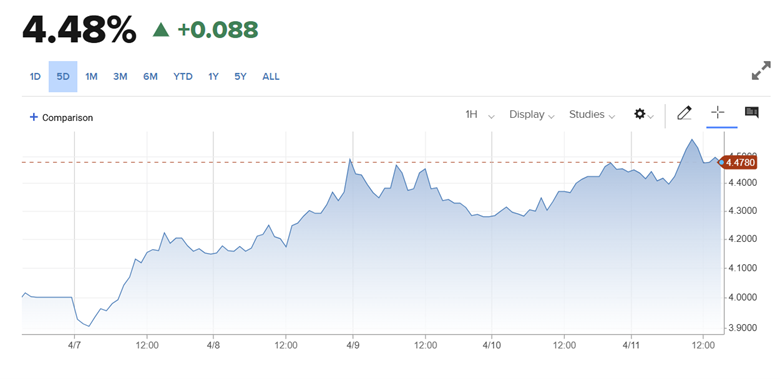Changes in the Force
Recent tariffs have introduced significant volatility across equity and fixed income markets. Initially, it was expected that President Trump’s tariff approach would echo that of his prior term, targeting specific goods like Chinese steel with limited consumer impact. However, the scope has broadened to blanket tariffs across nations at much higher rates than previously anticipated. While the recent announcement of a 90-day “pause” with a base tariff rate of 10% on all countries but China, has calmed markets to some extent, uncertainty remains elevated, and it seems early negotiations are suggesting that zero-tariff agreements may not suffice due to non-tariff barriers complicating U.S. exports.
While not explicitly stated, President Trump’s continued remarks point to China as the primary focus of these tariffs and the perceived largest beneficiary of the United States’ trade deficits. Increasing tariff rates between the U.S. and China, without the extension granted to other nations, underscore this tension and signal what might be a prolonged conflict as neither country seems to want to provide concessions at this time. The memories of COVID-19 supply chain issues seem to be seared in the minds of this administration and a leading reason for their focus on reshoring industries.
Markets are forward-looking, so when unexpected policy changes, such as abrupt tariff announcements are made, the future becomes more opaque, driving sharp increases in market volatility. This volatility is amplified when investors’ tariff expectations, used in their pricing models are disrupted, forcing rapid updates and significant market price adjustments. Over the last few weeks, U.S. equities have experienced a dramatic whipsaw effect due to these dynamics. For instance, the S&P 500 plummeted 10.5% over two days following the April 2, 2025, tariff announcement. On April 8, the S&P 500 saw an intraday range of approximately 8.2%, the largest move since the COVID-19 market turmoil in 2020. However, a partial tariff pause announcement on April 9 spurred a remarkable recovery, with the S&P 500 surging 9.5% in a single day, its third-best daily performance since 1940.
In addition to equity market volatility, U.S. Treasury yields have defied their typical safe-haven behavior, rising nearly 0.60% from recent lows, while gold has continued to increase in price. This unusual movement reflects broader macroeconomic concerns and offers insight into the administration’s recent policy decisions. The significant move up in Treasury yields paired with the dramatic stock decline, could very well explain President Trump’s about-face (the 90 day “pause”). Importantly, Trump also removed tariffs on Chinese-made smartphones and other electronic devices. A reasonable assumption is that this administration realized that other countries may counter protest the tariffs through the selling of U.S. treasury holdings, effectively further pushing United States Treasury rates up, the opposite effect of what this administration was likely hoping to see happen.

It is impossible to predict what the ultimate outcome of Trump’s shifting trade policy may be. However, we would expect to see an upward pressure on input prices and a negative impact on GDP growth in the near term. How much of said cost increases are ultimately passed on to the consumer remains to be seen, but we would certainly expect the consumer to bear a meaningful amount. In remarks made today at the Economic Club of Chicago, FOMC Chairman Powell made it clear that the Fed will remain on hold until the Trump administration’s policies become clearer, and data begins to reflect the impact of those policies.
Major economic changes and heightened volatility highlight the importance of portfolio diversification, including hard assets like gold, alternative investments and short duration fixed income. Sometimes, the typical diversifiers, like long-date treasury bonds, lose some of their expected hedging properties due to broader changes to economic underpinnings that have previously been the status quo. While we are not yet in a position to understand the longer-term implication of these tariffs and other dynamics, it is important to recognize the current economic shifts taking place and digest information impartially as it becomes available. Historically, it has proven unfruitful to react emotionally or in an extreme manner when unforeseen circumstances ignite volatility and uncertainty.
As always, please do not hesitate to reach out directly to our team for further discussion.
Regards,
|
Josh L. Galatzan, CIMA® |
Kirk Price |
|
Chris J. Popso |
Brian J. Noonan, CEPA |
|
Meagan Moll, CIMA®, CFP®, CPWA® |
The content of this publication should not be regarded as a complete analysis of the subjects discussed. All expressions of opinion reflect the judgment of the authors on the date of publication and are subject to change. There is no representation or warranty as to the current accuracy, reliability or completeness of, nor liability for, decisions based on such information and it should not be relied on as such. Information presented should not be construed as personalized investment advice or as an offer to buy or sell, or a solicitation of any offer to buy or sell the securities mentioned. Content is derived from sources deemed to be reliable. Any projections, market outlooks, or estimates are based upon certain assumptions and should not be construed as indicative of actual events that will occur.
Different types of investments involve varying degrees of risk, and there can be no assurance that any specific investment or strategy will be suitable or profitable for an investor’s portfolio. All investments have the potential for profit or loss. Past performance does not ensure future investment success.
Index returns do not represent the performance of Meridian Wealth Advisors or any of its advisory clients. Historical performance results for investment indexes and/or categories, generally do not reflect the deduction of transaction and/or custodial charges or the deduction of an investment advisory fee, the incurrence of which would have the effect of decreasing historical performance results. There can be no assurances that an investor’s portfolio will match or outperform any particular benchmark.
